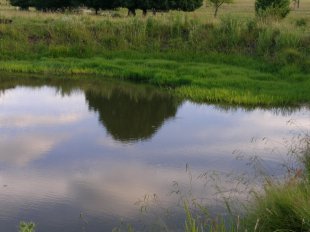
Water couch
SCIENTIFIC NAME: Paspalum distichum (formerly P. paspalodes)
CATEGORY: C4 perennial
IDENTIFICATION TIPS
- Warm season, mat forming perennial grass, 5-50 cm tall, spreading by rhizomes and stolons
- Seedheads consist of two erect branches 2-7cm long, forming a v-shape with hairs at the junction
- Spikelets minutely hairy, occurring in two rows along the branches
- Flowers late spring to autumn
CLIMATIC & SOIL REQUIREMENTS
- Prefers heavy clay soils, in or near still or slow flowing fresh water, such as along river and creek banks, around swamp margins and dams; can withstand dry periods
GRAZING & NUTRITIONAL VALUE
- High grazing value
- Digestibility of green leaf ranges from 57-72 %
- Crude protein 8.5-11 %
MANAGEMENT STRATEGIES
- Grows rapidly when conditions are moist if temperatures are above 20°C
- Sensitive to frost, although the effect is reduced if surface water is present
- Both stem and leaves provide high quality, palatable feed
- Useful coloniser and stabiliser of waterways, but may cause blockages of drainage channels if not managed
- Resistant to stock grazing and trampling, but is sensitive to shading. Performs best if kept short to reduce competition from taller species. Use short-term grazing to reduce pugging
- Seedheads rarely infected by an “ergot” fungus that could poison stock
- Seed can be sown, but most often planted using sprigs in late spring and summer. Sprigs can grow at up to 30cm a week during summer. Can also be spread by using seed bearing hay
SIMILAR PLANTS
- Couch (Cynodon dactylon) is vegetatively similar, but grows in drier areas and has a windmill type seedhead

(Water couch growing in dam edge: H Rose)

